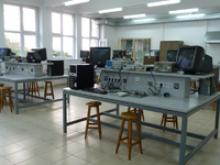Electrical Measurement and Networks Laboratory

Related Classes:
EE140 (Digital Systems), EE208 (Basic Circuit Design and Measurement), EE598 (Advanced Digital Design)
Equipments:
- 17 Bread Board/Full Kits (SC-2075 prototyping Signal Accessory Box with Output Cables), 15 Data Acquisition Toolboxes (NI PCI 6221(M Series) Multifunction I/O&NI-DAQ), 2 Data Acquisition Toolboxes (NI PCI 6052E Multifunction I/O&NI-DAQ), 17 FPGA Boards (Xess XSA-200), 17 Extender Boards for FPGAs (Xess XST-3)
- Analog and Digital multimeters, Oscilloscopes, Signal generators, True RMS Voltmeters, Vacuum Tube Voltmeters
- PCB manufacturing equipments: Ultra Vitalux UV Lamp,oven, chemicals, PCB cutter, a mechanic drill.
- 16 Personal Computers
Purpose:
Electrical Measurement and Networks Laboratory is designed to provide the student with the knowledge to use basic measuring instruments and techniques with proficiency. These techniques are designed to complement the concepts introduced in classes. In addition, the student should learn how to effectively record experimental results and present these results in a written report. More explicitly, the Laboratory objectives are:
1. To gain proficiency in the use of common measuring instruments;
2. To enhance understanding of electric circuit analysis concepts.
_ Inductance, Capacitance, and reactance
_ AC and DC voltages and currents. Phasors
_ AC power (real and reactive, instantaneous and average)
_ Series and parallel resonant circuit behavior
_ Rectifier Circuits
_ Transfer functions
_ Statistical Sampling
3. To draw schematic diagrams and simulate simple analog circuits using SPICE and manufacture printed circuit boards.
4. To build digital circuits and use National Instruments’ data acquisition toolboxes and LabView software to apply digital signals and acquire digital outputs.
5. To implement their very large scale digital systems which were designed using a higher level hardware description language (VHDL).
6. To develop communication skills through maintenance of succinct but complete laboratory notebooks as permanent, written descriptions of procedures, results, and analyses,
7. To compare theoretical predictions with experimental results and to resolve any apparent
differences.